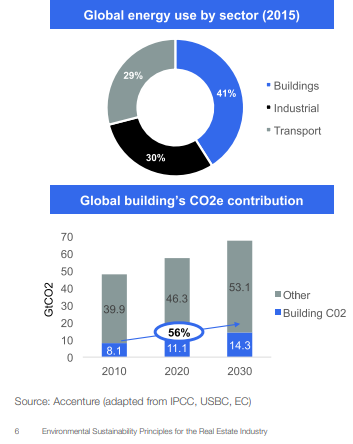Climate Change - Part 2: Property-paradise or housing-horror?
Posted Monday, December 9, 2019

In Part 2 of our series of blogs on Climate Change, we ask - how does the housing-market affect our planet?
Creating jobs to strengthen communities, using natural resources efficiently and innovative, sustainable designs. These are some ways that our developers remain environmentally sustainable and align efforts with the Paris Agreement’s 2°C limit. But are we doing enough?
Housing developers will tell you that the effects of climate change are "systematic" and that they are committed to reducing emissions to within a 2°C limit. However, what science tells us is that 2°C targets won't cut it, and the consequences of the climate emergency are anything but predictable. We can expect more frequent extreme temperatures, flash flooding and disasters such as high-speed winds knocking down electricity pylons yes, (this happened in 2014 - read about it here) but when and where this will happen is less foreseeable.
Settling for a 2°C target is not a viable or sustainable option for any business, as the International Panel on Climate Change (IPCC) tells us that we have until 2030 to 'avert' the climate-change headed our way. Changes made must deliver net-zero carbon pollution by this time, giving us 12 years to make decisions about the future of the industry (Landsec 2019).
What’s the issue with housing? Everybody has to live somewhere, right?
"Buildings and infrastructure account for ~35% of resources globally and almost 40% of energy use and carbon emissions". (Anne Johnstone 2018)

Read that again.
A huge 80% of the building stock in the UK that will be present in 2050 has already been built, with little thought towards energy-efficiency or carbon emissions. A recent report from the World Economic Forum (WEF) has put into numbers the effect of property on the climate:
- It consumes >40% global energy each year
- 20% of total greenhouse gases originate from buildings
- 40% of global raw materials (limited resources) are used by buildings
- 30% of the total waste in the EU is generated by buildings
- Projected 56% increase in CO2 emissions by 2050
- 12% of global freshwater will be used by buildings by 2030
Did you already know this? The kicker is, whether you manage building-sites, live in an apartment block or mow the lawns of housing estates - the fact that you have a roof over your head means that you contribute to these numbers.
With the world population projected to reach >8 billion by 2030 (WEF 2019) – that’s just 10 years - we can expect more than 60% of people to be living in urban space and growth of the construction and property sectors will need to follow suit.
The WEF project that the 750 largest cities in the US will need 260 million new homes and 540 million m2 of new office space. How will these be designed to fit-in with environmental standards?
At the Conference of the Parties in Paris (COP21), parties to the United Nations Framework Convention on Climate Change (what is the UNFCCC?) agreed to keep global warming to below 2°C (ideally, 1.5°C). To do this, the World Bank estimates that the real-estate sector should reduce its total carbon-dioxide emissions by 36% by 2030. This means reducing annual energy use by 1.25%.
So the blame is on us. What do we do about it?
This blog may have you feeling all sorts of environment-anxiety – good! That means you care. The best thing to do is to harness what you’re feeling and use it to effectively reduce your emissions from the very smallest changes, upwards.
At Fexco Property Services, our aim is to ensure that we address these issues head-on from a property management perspective. In a series of blogs we will look at:
- What can be done by developers about this?
- What can property managers do?
- Apartment blocks
- Houses
- What can I do?
This series will arm you - whoever you are – with sound, effective advice on how to tackle climate change and protect yourself, your business and your clients from its unpredictable nature.
Read the next chapter for "Why does the climate crisis matter to me as a developer, and what can I do about it?".
Sources
https://landsec.com/sustainability/our-sustainability-strategy
http://www3.weforum.org/docs/GAC16/CRE_Sustainability.pdf

